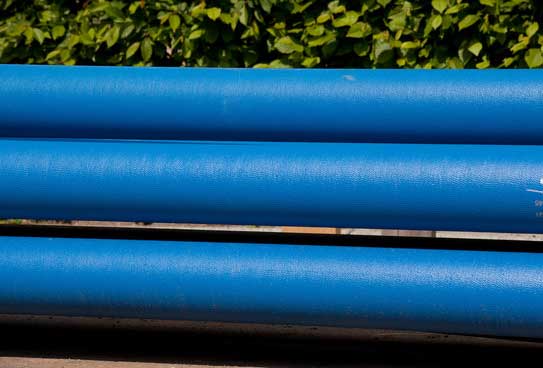Polybutylene is a type of plastic resin widely used in the manufacturing of water supply piping from 1978 through 1995. At that time, this system was considered revolutionary because the material was inexpensive and installation easy. Therefore, rather than copper systems, polybutylene was the preferred choice.
Although polybutylene pipes are commonly found in Northwest Pacific and Mid-Atlantic states, they are considered standard in the “Sun Belt,” a region that experienced extremely heavy residential construction through the 1980s. However, today experts recommend replacing polybutylene, which is also referred to as Qest (Quest) or Big Blue.
This blue or grayish colored pipe is also referenced to as a yard service pipe, poly pipe, or water service pipe found underground. While polybutylene pipes are found in a home’s interior, they are also used to carry water into a home from the outside.
While there are many benefits to polybutylene pipes, there are also reasons they should be replaced. The biggest issue is that in order for drinking water to be sanitized, chlorine is added, but this reacts with the polybutylene material, causing it to become brittle and ultimately fail.
Although failure can happen any time, it is commonly associated with change in ground temperature. With changes in temperature, the polybutylene expands and contracts, causing the brittle material to weaken and, over time, break.
Value of Replacement
Even when polybutylene pipes are in good condition, there are valid reasons for replacement.
- Water Damage – If for any reason a polybutylene pipe breaks within the foundation of a wall or anywhere near, water damage is imminent. Water that leaks into the home causes damage to flooring, drywall, air conditioning and heating units, furniture, personal belongings, and more.
- Mold – In homes built primarily before 1980, the biggest health risk was asbestos. Used in flashing, siding, insulation, ceiling tiles, floor tiles, roof shingles, joint compound, and more, airborne asbestos fibers cause cancer and other health-related problems. Today, the threat is mold, which can also lead to an array of serious health risks. If a home becomes water damaged because of a broken polybutylene pipe, mold can grow beneath carpeting, in walls, inside ductwork, and other small places.
- Exterior Pipe Break – If a pipe breaks on the exterior of the home, soil can wash away under driveways, walkways, and sidewalks. Not only does this lead to cracks, but the bigger risk is ground giving away and someone becoming injured.
- Utility Bills – Even small leaks that go unnoticed can create big problems down the road. For instance, monthly utility bills increase, which only worsens as the leak worsens.
- Water Pressure – These pipes typically measure ½ to 1 inch in diameter. Based on size, many people do not enjoy full water pressure; once the pipes are replaced, pressure improves.
- Hot Water – When new pipes are installed with an optional hot water recirculation system, there is never a shortage of hot water. While beneficial for everyone, this is especially great news for larger families.
- Peace of Mind – There is a peace of mind knowing that outdated and potentially dangerous polybutylene pipes are replaced.
- Home Value – A home’s value automatically increases. For someone interested in selling at some time in the future, letting potential buyers know that old pipes have been replaced is not only a huge selling point, but also provides a little negotiating power.
The Decision to Replace
As shown, there are many reasons to have polybutylene pipes replaced, but this is not a decision that anyone should take lightly. Yes, a leak in the piping system can cause literally thousands of dollars in damage, not to mention more expensive monthly bills, but replacement is a big undertaking.
On average, polybutylene pipes begin to leak after nine years. Considering they were last used in 1995, there are millions of people with this type of system, many who have no idea. Therefore, the first step involves determining the type of pipe system, which is easiest done by hiring a professional plumber.
The plumber will conduct several visual inspections, including looking at the color and diameter of existing pipes. A professional will also know where to look. Again, polybutylene pipes are used both inside and outside of the home. From an interior perspective, they are commonly found close to hot water heaters, under sinks, and going into toilets.
However, polybutylene pipes are also located in the crossing of basement ceilings, come in through basement walls, are connected to the water meter on the home’s exterior, or are attached to the main water shutoff valve.
Keep in mind that sometimes, copper fittings are used in conjunction with polybutylene pipes, so if someone decides to conduct an inspection without the assistance of a plumber, seeing copper does not mean the pipes are not made from polybutylene.
